Sales Forecasts: Everything You Need to Know
Casey O'Connor
Contents
- What Is a Sales Forecast?
- Why Is Sales Forecasting Important?
- Who Is Responsible for Sales Forecasts?
- Who Uses Sales Forecasts?
- What Data is Included in Sales Forecasts?
- How to Choose a Sales Forecasting Method
- 6 Steps to Create an Accurate Sales Forecast
- Factors That Can Impact Your Sales Forecast
- Tips for Successful Sales Forecasting in 2023
A sales forecast is a data-driven prediction of future sales benchmarks.
Sales forecasting is an important exercise for any sales team that wants to see significant year-over-year growth and gain the ability to fine-tune their sales process in specific, targeted ways.
In this article, we’ll go over the basics of sales forecasting, as well as the exact steps your company should follow to create your own.
Here’s what we’ll cover:
- What Is a Sales Forecast?
- Why Is Sales Forecasting Important?
- Who Is Responsible for Sales Forecasts?
- Who Uses Sales Forecasts?
- What Data is Included in Sales Forecasts?
- How to Choose a Sales Forecasting Method
- Steps to Create an Accurate Sales Forecast
- Factors That Can Impact Your Sales Forecast
- Tips for Successful Sales Forecasting in 2023
What Is a Sales Forecast?
A sales forecast is a data-driven prediction of the financial outcomes a business is most likely to see at the end of a given time period.
Your sales forecast can include monthly, quarterly, yearly, or multi-year projections, and can also be individual or company-wide.
Why Is Sales Forecasting Important?
Sales forecasts are worth the time and effort required to create them. An accurate and thorough forecast can make a significant difference in how efficiently a company meets its goals.
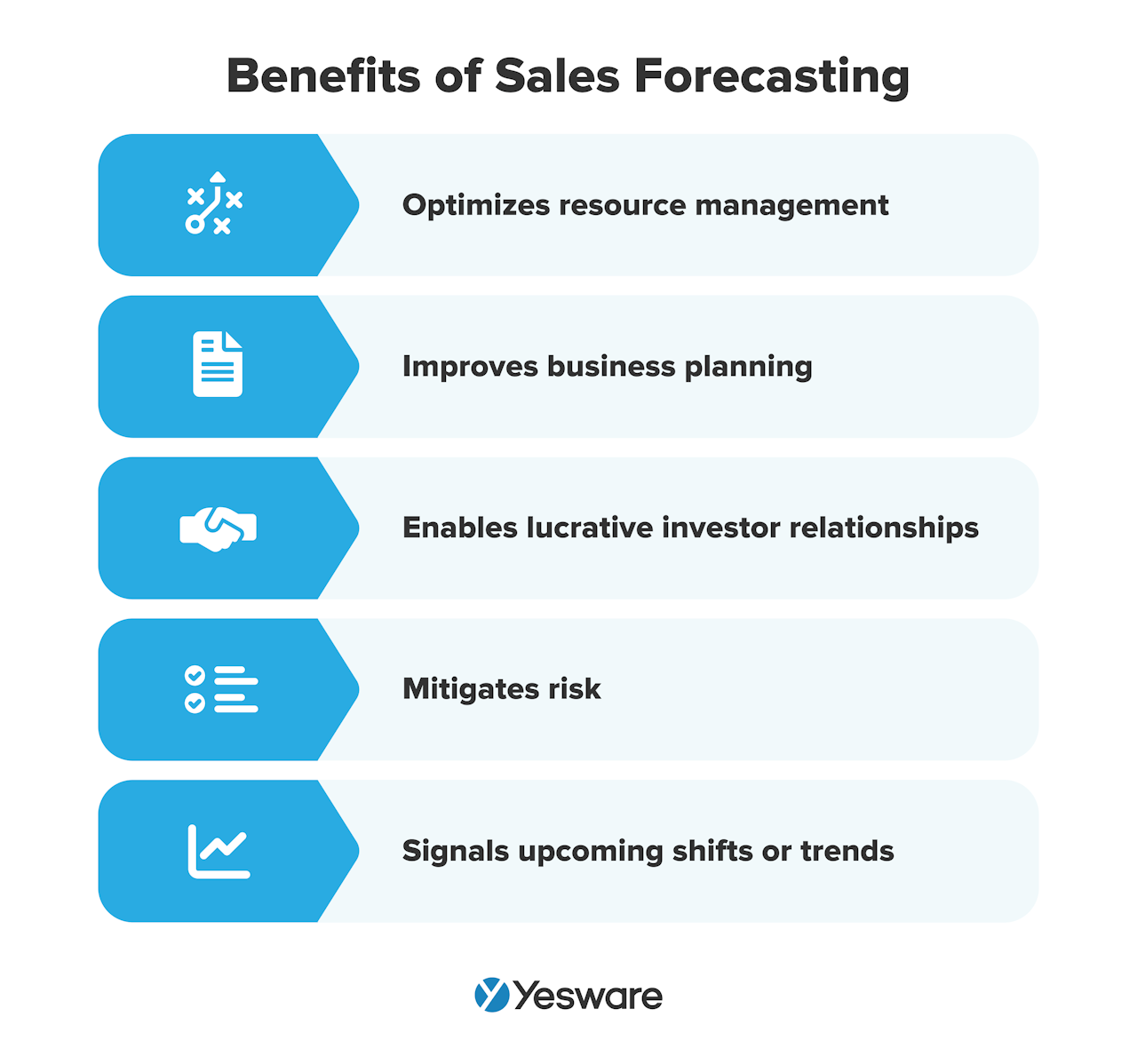 A whopping 97% of companies that implement sales forecasting meet their quotas; in other words, nearly all companies who consistently meet revenue targets are using sales forecasts to guide them.
A whopping 97% of companies that implement sales forecasting meet their quotas; in other words, nearly all companies who consistently meet revenue targets are using sales forecasts to guide them.
On the other hand, only 55% of companies without sales forecasts are able to meet their quotas.
It’s clear that sales forecasts are a critical component for any company that wants to meet their sales goals. Let’s take a look at some of the ways sales forecasting can help improve your sales performance.
Inventory Management
An accurate sales forecast can help you confidently predict how much product stock to order, and when. Proper inventory management can have a huge impact on salespeople’s success.
Nothing is more frustrating to sales leaders than running out of stock when demand is high; trying to offload surplus inventory can also impact your financial resources.
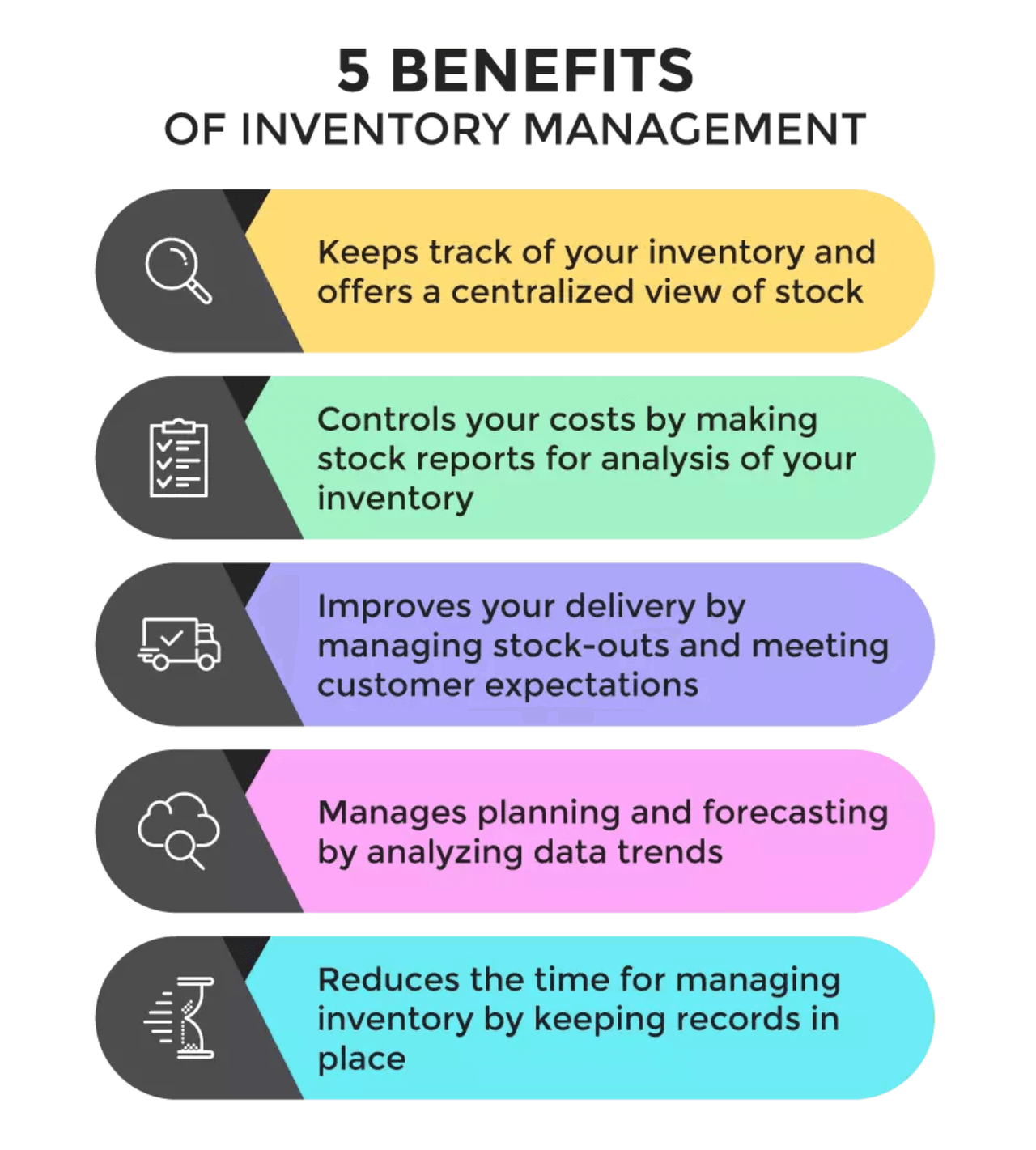 Sales leaders can use projected sales data to effectively manage their inventory purchases. This is an especially important step for businesses impacted by seasonality.
Sales leaders can use projected sales data to effectively manage their inventory purchases. This is an especially important step for businesses impacted by seasonality.
Business Planning
Sales forecasting is also a necessary step for creating an accurate business plan. Your sales forecast can help you estimate the timing and volume of expected sales revenue.
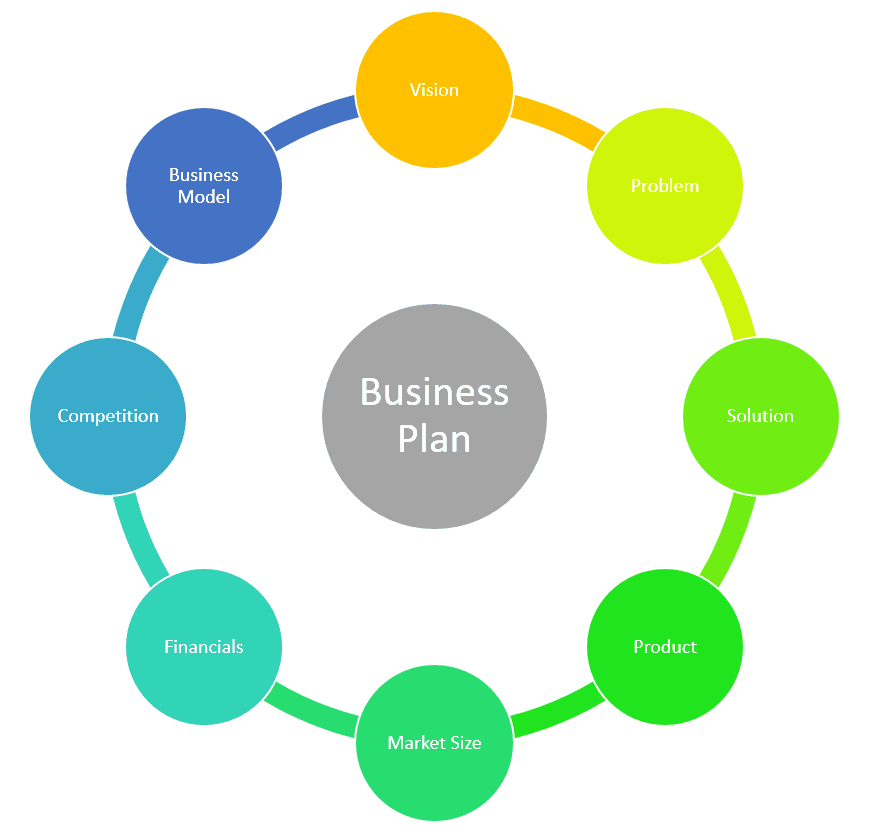 An accurate sales forecast can help sales managers and C-suite executives with budgeting and cash flow, which will allow them to make the necessary business decisions to allocate appropriate resources for:
An accurate sales forecast can help sales managers and C-suite executives with budgeting and cash flow, which will allow them to make the necessary business decisions to allocate appropriate resources for:
- Marketing
- Future hires
- Expanding territories to generate new business
They can also help you tweak any underperforming segments of the sales pipeline, or change course in your sales strategy if what you’re doing isn’t working. Making these kinds of adjustments in real-time is always preferable to waiting until the end of the quarter or fiscal year when it’s too late to do anything about it.
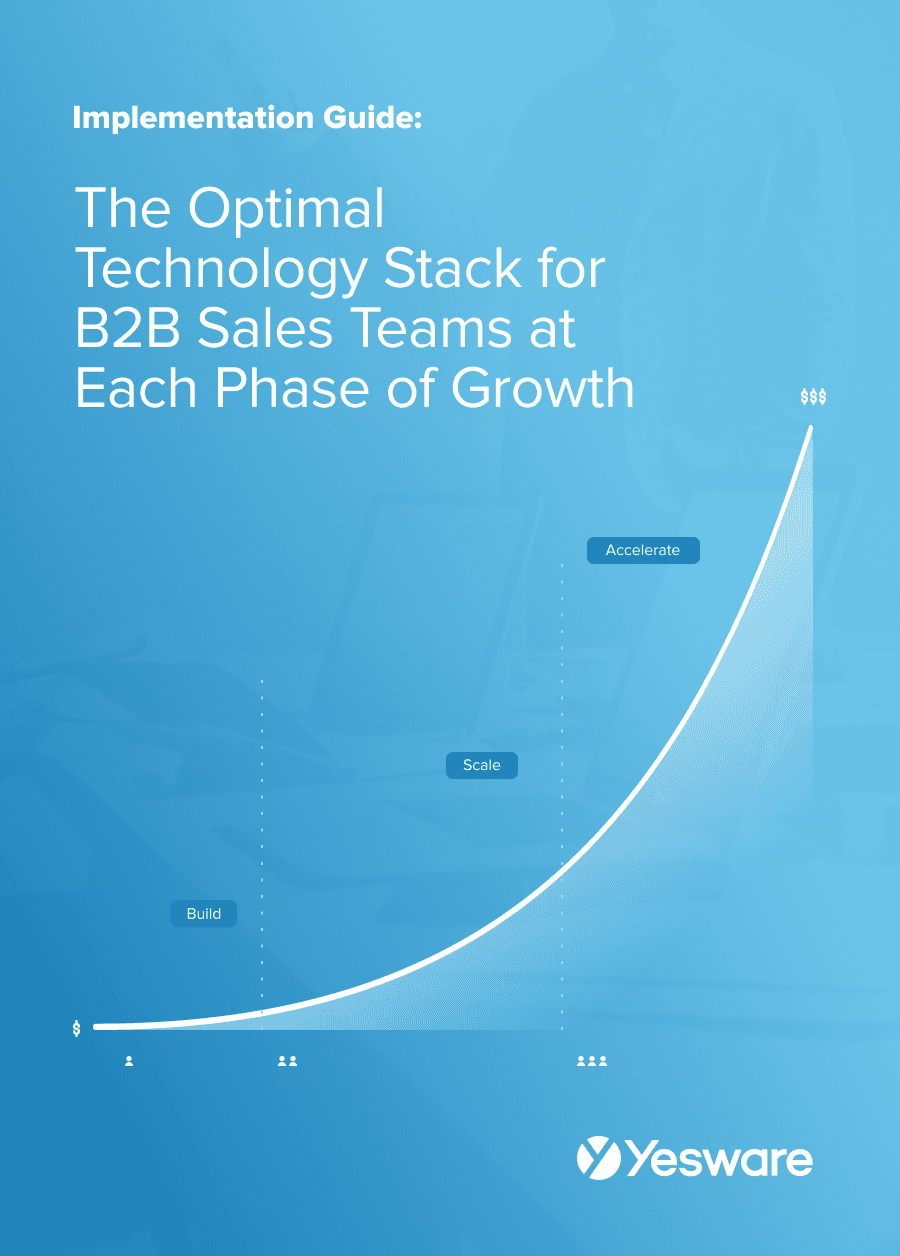 The Optimal Technology Stack for B2B Sales TeamsUsing data from the most successful business-scaling models, we designed a blueprint for the exact technology your business needs at each phase of growth.
The Optimal Technology Stack for B2B Sales TeamsUsing data from the most successful business-scaling models, we designed a blueprint for the exact technology your business needs at each phase of growth.
Investor Partnerships
For startups and small businesses looking for capital, sales forecasts can also be a great way to earn the trust of potential investors and show that your business can provide a worthwhile return on investment.
In general, investors will want to see your month-to-month cash flow, as well as your overall profitability. It’s likely that they’ll want to see three-year and five-year projections, as well. If you’re a new business or are lacking the past sales data to project out to that time frame, that’s okay. Remember that sales forecasts are meant to be tweaked along the way.
Who Is Responsible for Sales Forecasts?
In general, the sales management team is responsible for taking the lead in creating the sales forecast.
That being said, though, the most accurate forecast will come from lots of collaboration between many professionals, sales, and otherwise.
- Sales: Everyone on your sales team should have an active role in the forecasting process. They are, after all, the ones “in the trenches,” and can offer valuable insight into the customer relationship, length of the sales cycle, and the overall sales process.
- Finance: Your finance department can help you dig into both your historical data, as well as your current baselines (e.g., current monthly sales, annual revenue, revenue by rep, etc.) to calculate your predicted growth rate.
- HR: The HR team can help you get a handle on how much it will cost to hire new salespeople in the future. This kind of data will help you understand how to best set your goals for the future.
- Marketing: Your sales forecast will be driven by data from your marketing team and will also help you allocate the appropriate resources to marketing for the future.
- Production & Supply Chain: Your finished forecast will help the supply team know when and how much stock to re-order and the production team should be able to provide historical data for the sales team about order trends, seasonality, and run rate.
- IT: Don’t overlook the importance of great software to make sales forecasting easier. Talk to your IT team to make sure you’re getting as much data as possible from your CRM. You might also have a conversation about investing in software with predictive analytics.
Remember, the sales forecast is a team effort. While it may be challenging to align calendars and come to a consensus, the document will be much more valuable if the whole team is involved in creating it.
Who Uses Sales Forecasts?
Some sales reps are surprised to learn just how useful sales forecasts can be — they’re not just for the number nerds! The implications of sales forecasts are, in fact, far-reaching, and impact many departments across the organization.
- Sales Managers: Sales managers use sales forecasts to help their decision-making process. Accurate forecasting can help sales managers select effective sales strategies to meet new sales goals.
- Marketing Teams: Sales forecasts help marketing professionals get a better sense of what their campaign requirements will be, and where to find their most promising opportunities.
- Finance and Accounting: It’s obvious why sales forecasts are important to finance teams. Accurate forecasts help accounting teams have transparency into where the company money is going. How much is being spent on marketing? What’s the ROI on each campaign? How is cash flow? Where do we need to invest? How do we need to budget? Finance teams can gain a lot of insight from an effective sales forecast.
- Product Managers: The people responsible for meeting product demand use forecasts to help them plan their supply chain needs. They need to know how much inventory needs to be kept on hand, and the optimal to invest in a restock.
- Human Resources: The HR department can use sales forecasts to help them plan their hiring process for the next quarter or year.
- Sales Operations: Sales ops rely on accurate sales forecasts for territory planning and quota assignments.
What Data is Included in Sales Forecasts?
The more accurate your sales forecast is, the more functional and valuable it becomes.
It can be overwhelming to sort through the various data and opinions available when it comes time to forecast, but getting this right is important; sales teams who had more accurate forecasts had 13.4% more year-over-year growth than those who were inaccurate.
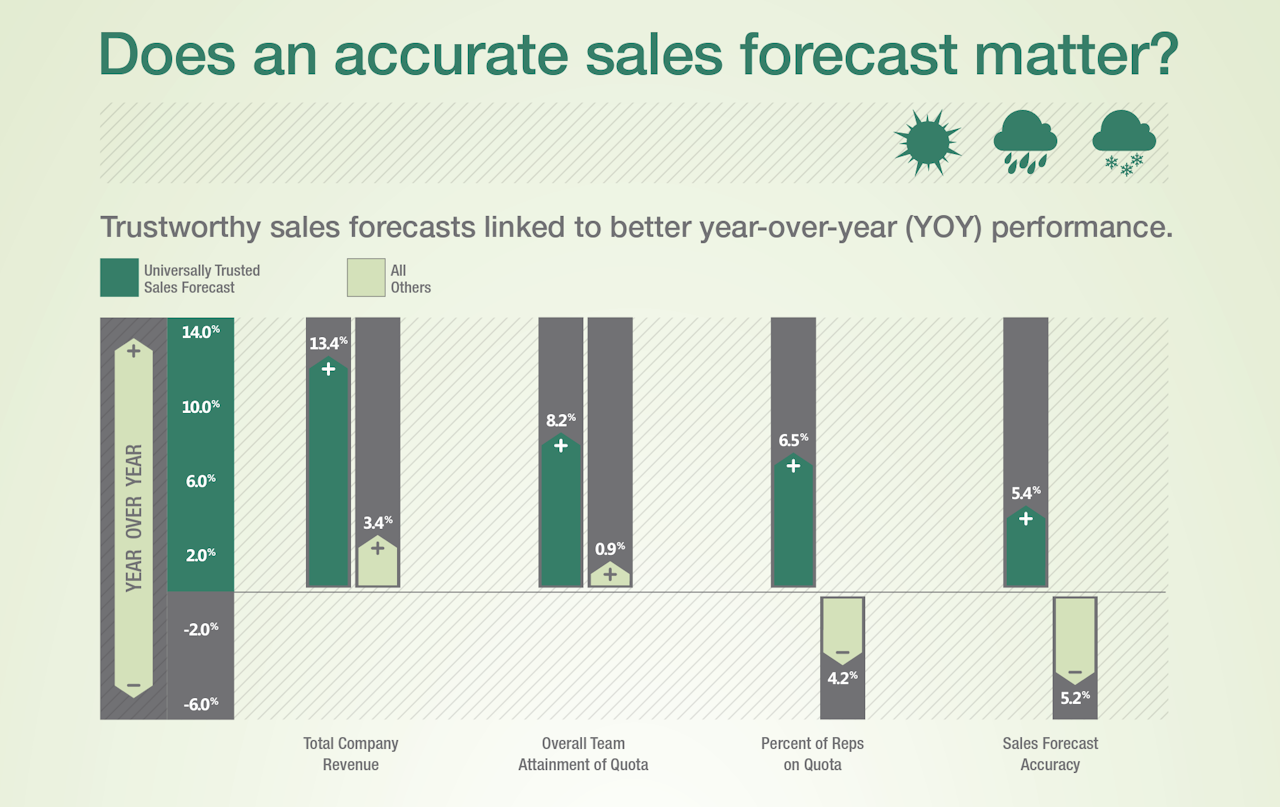
Consider analyzing the following data when making your sales forecast.
- Sales quotas, both individual and team-wide
- Your overall sales process (length of the sales cycle is particularly relevant)
- Sales KPIs and metrics from each stage of the funnel
- Past performance and historical sales data
- Average annual contract value
- Conversion rates
- Customer acquisition cost
- Monthly and annual revenue
- Attainment
- Pipeline coverage
Depending on your specific company and forecast needs, there may be other pieces of data that will create the best-fit forecast for your team. Be sure to talk to the various departments outlined above and, when needed, go back and add to or tweak your forecast as more information becomes available.
How to Choose a Sales Forecasting Method
There are many ways to create a sales forecast (check out our post: 20+ free sales projection templates), but most can be broken down into two major formats: top-down or bottom-up.
Bottom-Up
Bottom-up forecasting starts with the number of units a company will sell, then multiply that number by the average cost per unit. From there, you then multiply by the time frame for which you’re hoping to forecast.
You can follow this format to itemize revenue by territory or by sales rep, by month or by year. The bottom-up method is very easy to change or update as needed and can give an extremely detailed view of the sales outcomes your team is likely to see.
Top-Down
Top-down forecasting can be a bit more complicated. The top-down forecast starts by looking at your total addressable market (TAM). From there, you’ll estimate what percentage of the TAM the company can reliably capture.
There is no right or wrong way to forecast your sales. In truth, it’s prudent to forecast from both bottom-up and top-down. You can, for example, start with top-down, and then repeat the process bottom-up to see how realistic your first forecast looks.
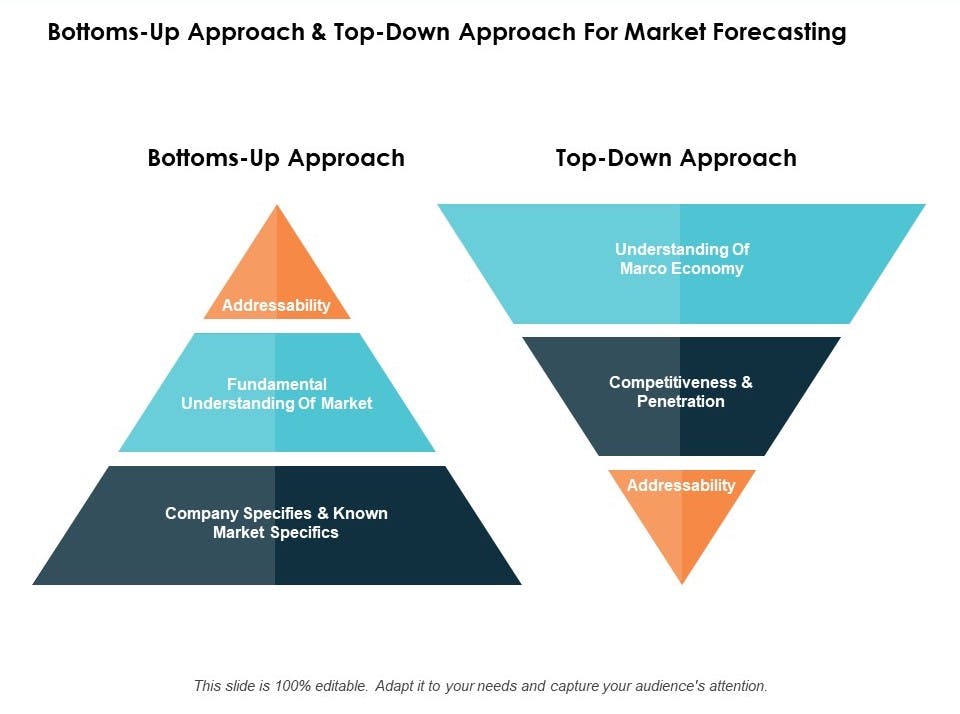
Remember that things can change according to company policy, personnel changes, economy or market changes, seasonal fluctuations, new product offerings, and other factors. Add in, take out, or tweak what’s needed.
6 Steps to Create an Accurate Sales Forecast
No matter how young or well-established, big or small your business is, it’s likely that your team has enough data to create your own sales forecast.
For businesses without a lot of historical sales data, work with the numbers you have and make educated guesses where necessary. You can always come back and update your forecast as more data becomes available.
The following steps will help you create an accurate, powerful sales forecast (remember to check out the many templates here to get you started).
1. Standardize Your Terminology and Metrics
Before crunching any numbers, it’s important to make sure your entire team is using the same terminology and KPIs. Spend some time before forecasting making sure everyone is on the same page about the lingo you use and how you define it.
2. Set Goals
While sales forecasting isn’t quite a goal-setting exercise, it’s important to make sure the projections you come up with are in line with your company goals. Use the SMART goal framework to create productive and motivating goals.
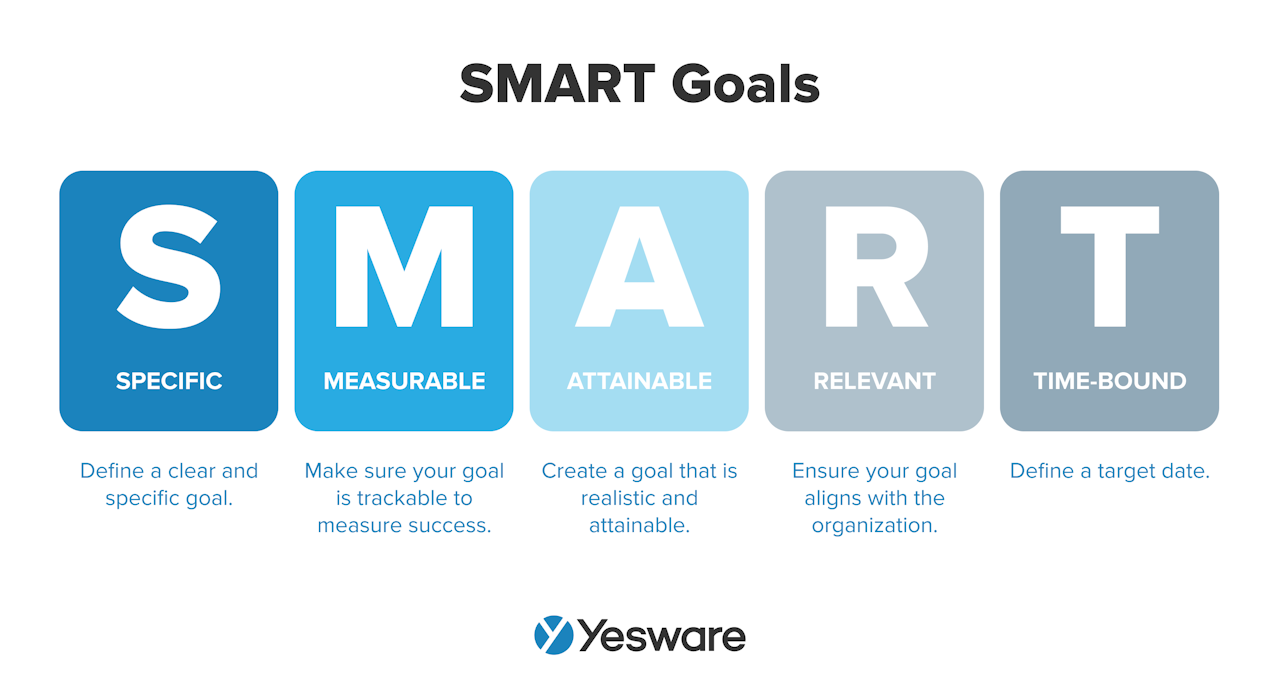
3. Look at Historical Sales Data
Here’s where the actual forecasting begins.
Gather as much historical sales data as you can. If you’re not sure where this information is aggregated, talk to your sales manager or finance department.
Break down the numbers as specifically as possible. You’ll want to see the data broken out by sales rep, by territory, and by time frame.
4. Anticipate Changes
While you won’t be able to foresee every change, update, or disruption to your pipeline before you create your forecast, it will be helpful to take note of any upcoming and noteworthy changes.
If you anticipate hiring new reps in about 6 months, for example, that should be included in your forecast. Also consider whether there will be changes to the budget, new products added to your pipeline, territory expansions, or any promotions or deals to be offered in the future.
Finally, be sure your forecast reflects any larger-scale changes or disruptions to your overall market.
5. Reference Your Sales Process Map
If your team uses a sales process map, use it as a point of reference when creating your forecast. The map will help you ensure that you’re capturing every step of the process, which will make your results more accurate.
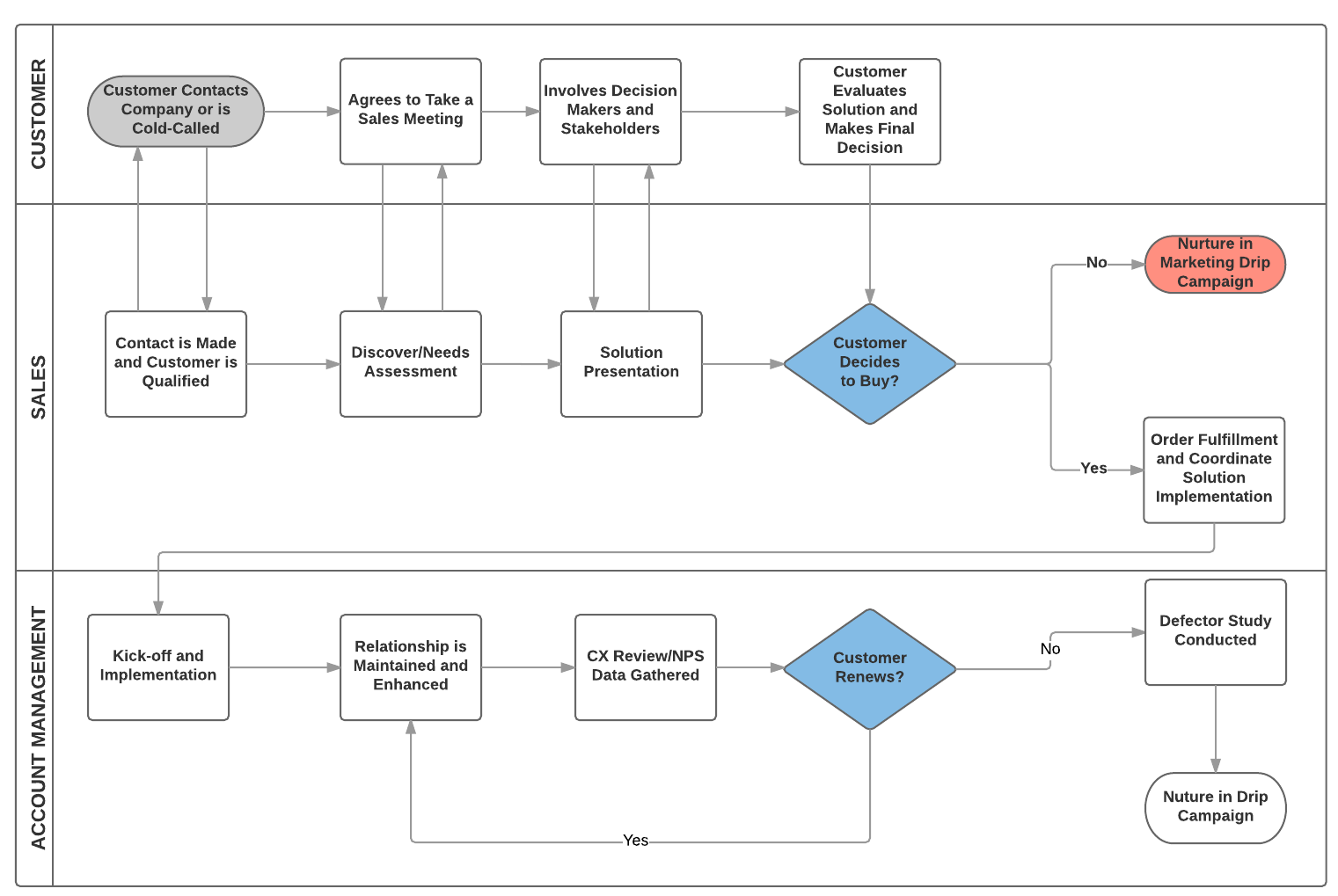
6. Be Timely
As a sales rep, it’s important to make sure you’re submitting or updating your sales metrics in a timely manner.
One of the benefits of having a sales forecast is that it can help you detect a change in the wind, so to speak, and give you a chance to correct your course if sales activities aren’t up to par. That benefit will only play out, though, if data is entered quickly and accurately.
Factors That Can Impact Your Sales Forecast
Although it’s ideal that sales forecasts are as accurate as possible, the truth is that there are many factors — both internal and external, and within your control and outside of it — that can impact the accuracy and effectiveness of your sales forecast.
Internal Events or Concerns
There are many things that happen within a company that can impact sales forecasts. These can be both positive and negative events.
A high employee turnover rate, for example, will definitely have an impact on sales forecasts. It’s hard to be accurate in predicting revenue when you can’t rely on a set number of salespeople working at any given time.
On the flip side, faster-than-expected growth can also skew the efficacy of sales forecasts.
Shift in territory, new company policy, product updates or launches, shifts in sales pricing strategy, and other minor or major fluctuations in your everyday operations can all have an impact on sales forecasts.
Economic Conditions
The state of the economy in general can also influence the way a sales forecast is calculated.
Turbulent economic times mean less buyer confidence in general and less confidence in the reliability of the forecast itself.
Trends in Your Industry
Looking at the events in your industry as a whole can certainly play a role in determining your sales forecast.
Is the market demand for your solution strong, or is it wavering over time? How are your competitors faring in the market? How much market share do you have relative to each of them? Are you pursuing any new major accounts? How can you tap into new customer segments?
The answers to each of these questions will factor into the way your sales forecast comes to fruition.
New Legislation
For some industries, frequent policy updates for things like compliance and legal implications can have a huge impact on sales forecasts. Many companies, for example, face constantly-changing regulations that come with hefty fees if not properly followed.
If organizations don’t stay up-to-date on their obligations and industry regulations, they risk losing revenue opportunities.
Marketing Strategies
How effective are your current marketing strategies? Do they produce a reliable and predictable number of leads each cycle? How often do you introduce new strategies, and what is your method for tracking their effectiveness? Have you optimized each of your marketing channels?
Insights into marketing can often offer similar insight into the state of your sales forecasts.
Tips for Successful Sales Forecasting in 2023
The following tips will help you create a reliable, predictable process for successful sales forecasting.
Be Transparent
As we outlined earlier, sales impacts have far-reaching implications across several departments within an organization. It’s important to be timely and thorough in how you share sales forecast information internally.
Make sure to include copies for all of the following departments, in addition to any others in your specific organization who request one: marketing, finance/accounting, product development/management, human resources, and sales operations.
Be Organized
Accurate sales forecasts require impeccable organization. Data should be updated carefully and on a regular basis. Systemize all of your reporting to the best of your ability.
Sales accounting software and sales forecast dashboards can help your team stay on track with their forecast inputs.
Automate Everything
Most sales forecast software offers users a tremendous amount of automation capability. Maximize those features; it will save your sales reps valuable time and effort.
Collaborate
Sales forecasts will be most accurate and reliable when they’re created from ample input. The same parties who should receive a copy of the sales forecast should also have a hand in creating it.
Use Data
While there are a few components of a sales forecast that rely on a sales manager’s educated guess, much of it requires a data-based approach. Make sure everyone who has input in and access to sales forecasts has a common understanding of the terms used during your sales processes and understands the expectations around how and when to update data.
Updated in Real Time
Sales forecasts are most useful when they’re generated using data from a medium-to-long period of time.
That being said, however, accurate sales forecasts also require real-time, up-to-the-minute updates as your business grows and changes over time.
Stay on top of data updates as needed. Over time, you’ll get a sense of what needs to be updated regularly, and any anomalies that you may encounter.
This guide was updated on February 14, 2023.
Get sales tips and strategies delivered straight to your inbox.
Yesware will help you generate more sales right from your inbox. Try our Outlook add-on or Gmail Chrome extension for free, forever!
Related Articles
Casey O'Connor
Casey O'Connor
Casey O'Connor
Sales, deal management, and communication tips for your inbox

